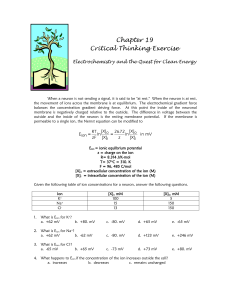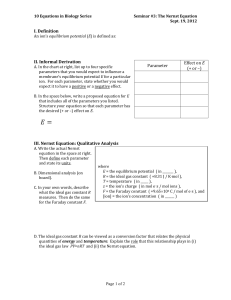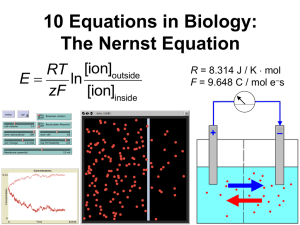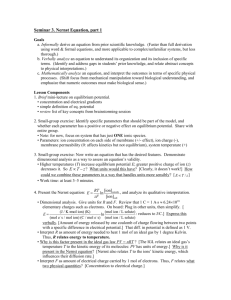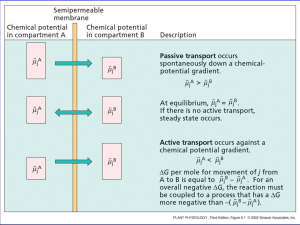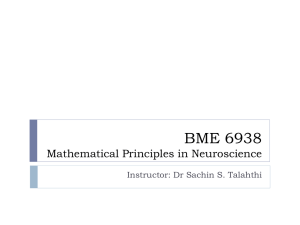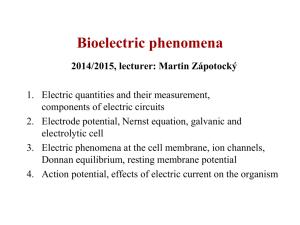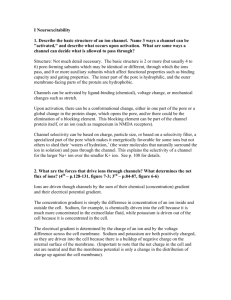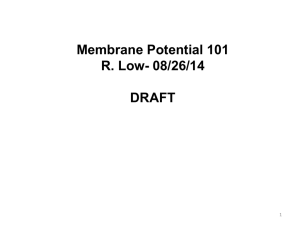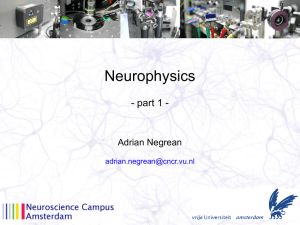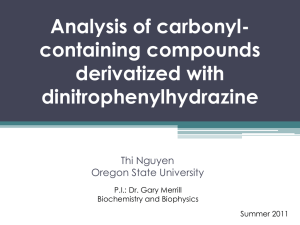Week 2 Membrane Potential and Nernst Equation
advertisement
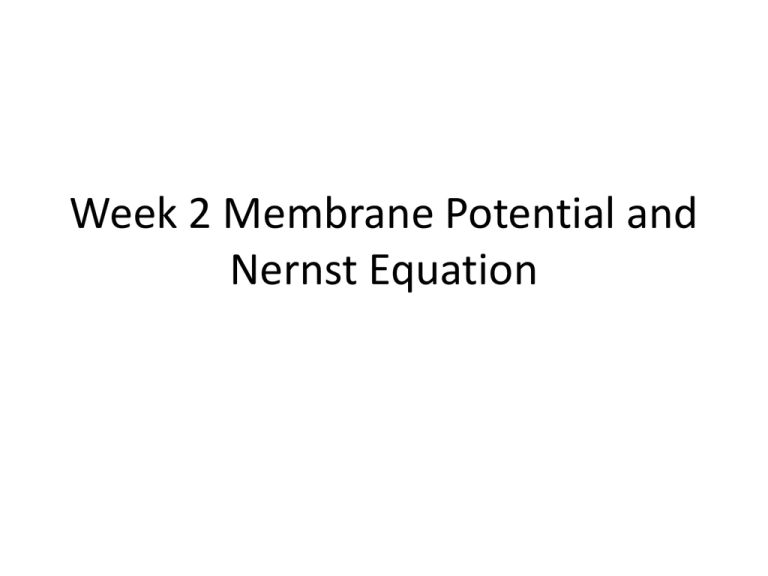
Week 2 Membrane Potential and Nernst Equation Key points for resting membrane potential • Ion concentration across the membrane • Eion: Equilibrium potential for an ion, and how to use Nernst Equation to calculate it • driving force = Vm – Eion Vm is the membrane potential of the neuron at that time, not always the resting membrane potential. Eion will change from the value in the table, depending on the ion concentration across the membrane, and the temperature. • Goldman equation: the ion channel permeability and ion concentrations of all the ions across the membrane decide where the membrane potential is at that time. • When the ion concentration and the channel permeability are the same as indicated in the table, Vm=VRMP, resting membrane potential • De-polarization and hyper-polarization: the former means the membrane potential of a neuron becomes more positive, and the latter means the potential becomes more negative. Nernst Potential • Calculates the exact value of the equilibrium potential for each ion in mV • Takes into consideration: – Charge of the ion – Temperature – Ratio of the external and internal ion concentrations Concentration gradient: K+ moving out Chapter 5 & 6: Ionic Basis of Membrane Potential Fact: Electrical gradient: K+ moving in In face, no net flux. Explanation: electrochemical equilibrium For single ion equilibrium potential, use Nernst Equation E ion ( RT / zF ) ln( C out / C in ) or Eion =2.303 RT/zF log(Co/ Cin) R is the universal gas constant (8,315 mJ/(K Mol)), T is temperature in degrees Kelvin (K = 273.16+C), F is Faraday’s constant (96,480 Coulombs/Mol), z is the valence of the ion (z = 1 for Na+ and K+, z = -1 for Cl-, and z = 2 for Ca2+). for K+ and Na+: Eion = 62 log (Co/ Ci) for Cl-: ECl = -62 log (Co/ Ci) for Ca2+: ECa = 31 log (Co/ Ci) Extracellular and intracellular ion concentrations for a “typical” neuron at its resting stage For example: EK = 62 log (5/100) EK = 62 (-1.3) EK = -80mV How to calculate E for an ion using given concentrations? To which direction an ion moves when its channel opens at a given time? Ions tends to move to the direction that brings the Vm to its own Em So driving force is the only thing you need to consider at this time! And only thinking about one ion at a time! Usually the neurons rest on ~-65mV, the difference (-15mV) is the driving force for K+ to move out try to reach K+ equilibrium potential Vm > EK (for example, -65mV > -80mV) K+ more outward, hyper-polarization Vm = EK no current/movement, I = 0 Vm < EK (more negative) K+ move inward, de-polarization Driving Force = Vm - Eion To estimat Vm and consider multiple ions, use Goldman V rest 58 log m 62 equation PN a [ N a ] o PK [ K ] o PC l [ C l ]i PN a [ N a ]i PK [ K ]i PC l [ C l ] o =-68mV The membrane potential is always driven toward the equilibrium potential of the ion to which the membrane is most permeable. That is why we have depolarization during action potential! - Threshold for massive amount of voltage gated Na+ channel to open - Rising Phase because of Na+ influx (try to bring Vm to its own ENa) - Falling Phase (PNa decreases, while PK increases. So K+ become the dominate one again) - Undershoot (afterhyperpolarization) Why K+ channel has the highest P at the resting stage? T1: voltage-gated Na+ channels open. It takes about 1ms for them to inactivate and for voltage-gated K+ channel to open T2 inactivate Rising phase T2, the voltage-gated Na+ channels inactivate and the voltage-gated K+ channels are opening Falling Phase T1 -55mV T3 Absolute Refractory Period Na+ channel inactivation Undershoot (after-hyperpolarization) T3, The voltage-gated K+ channels close Relative Refractory Period Na+ channel de-inactivated, it becomes possible to have another AP, just difficult Characteristics of Action Potentials: because they are voltage gated channels!!! 1. 2. 3. 4. 5. 6. Have a threshold for initiation (~ 10 mV depolarization above rest) All or nothing (below threshold = none, above threshold = all) Always depolarizing Constant amplitude (~100 mV) Constant duration (~2-3 msec) Have refractory periods a. absolute (during falling phase) b. relative (during undershoot a.k.a. afterhyperpolarization) 7. Propagate without decrement
